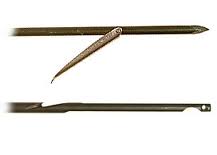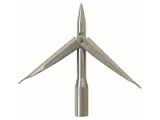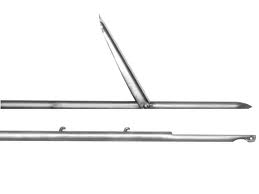Choosing a speargun Shaft
If you ever heard me say “they are all the same” I promise you, I was not talking about speargun shafts. It is the exact opposite. Some shafts are great and some are just terrible. Shafts by different manufacturers, are completely different when it comes to strength and quality. Most shafts that come with euro spearguns are plain stainless steel. Stainless steel is a soft metal and far too soft for our purpose. Better shafts are stainless steel that are put through a heating process and made into “spring steel”. This is much better for our purpose due to its increased strength and resistance to bending. The shafts made by the South African’s like Rob Allen are built different from both the above; they are oil-quenched carbon spring steel. They will rust if their protective coating comes off, but these shafts are tough and when I say they are tough I mean THEY ARE TOUGH! I have trouble drilling them even on a drill press. I have one of these shafts that is at least 9 years old. I commercially fished totaug and other fish for 3 years with it, and it has put 1000’s of fish on the dinner table. It is all rusted and looks like it’s been to hell and back, but, it is still straight and shoots true. Not to say these shafts can’t be bent, I have bent a few on big fish, but compared to stainless and spring steel shafts they stand alone.
Shaft size is your next Decision to make. Do you want 6.o mm, 6.5 mm, 7 mm, 7.5 mm, or 8 mm (find metric conversion chart below). They all have their own special place and purpose. Basically it is common sense and simple math. The thinner they are the faster they go, the less they penetrate, and the easier they bend, Hence, the bigger they are the slower they go, the more they penetrate and the harder they are to bend. That’s simple math and I like simple math, so lets keep it to that. So basically, in clean water with great visibility and smaller fish you might choose a 6.o mm , 6.5 mm or a 7 mm shaft. In lower visibility conditions with bigger fish you might choose a 7 mm 7.5 mm or a 8 mm shaft. There are other factors involved like band power, number of bands and type of gun, but we will keep this simple. I will say one thing you have to consider is the weight of the shaft. Heavy shafts will make light guns heavy/sink . Heavy guns as we know require more energy to use. Energy =increased O2 consumption and that’s bad. So your shaft should weight your gun close to neutral. If I had to choose one shaft for everything it would be the 7 mm shaft. That’s pretty much all I use. It weights most euro guns properly, has good speed and penetration. Two more decisions to make are, tip style and notch vs. pinned vs. shark fin type shafts.
metric conversion chart
| Inch/Foot | Metric |
| 1/8in | 3.175mm |
| 5/32in | 3.97mm |
| 3/16in | 4.76mm |
| 1/4in | 6.35mm |
| 9/32in | 7.14mm |
| 5/16in | 7.94mm |
| 3/8in | 9.53mm |
We will start with tip style. Basically your choices are double flopper, single flopper (Tahitian flopper) or breakaway tip’s. Breakaways are heavy and work best in bigger guns and bigger fish. Here in the northeast there is no great need for them considering we can’t shoot Bluefin tuna. The first time I used a break away tip; I shot a 40 + lb striped bass in the head, I spent the next 20 minutes on the deck of the boat doing surgery trying to get it out. It was no fun. Needless to say that was the first and last time I used one. In my opinion a good 3” Tahitian flopper that is set properly is the way to go for fish under 80 lbs. They are lighter than other choices so the shaft will fly true at greater speed. They are easy and fast to get out of the fish, and they hold the fish very well. By “set properly”, I mean the flopper should open up fully to a max of 45 to 55 degrees and stay open on the shaft while the shaft is held vertical. The way to test this is hold the shaft in a vertical position, in your left hand with the barb closed. Briskly strike the shaft above your left hand with your right hand. The barb should open to 45 degrees and stay open. A barb that doesn’t will lose fish. If yours is to loose you can fix it with a ball-peen hammer. Tap the round of the pin that holds the flopper with the round side of the hammer while the opposite side of the pin is against a hard surface. Just a little at a time until you get it just tight enough to stay open.
Now the back-end of the shaft. Picking a notched shaft, pinned shaft, or a shark fin shaft, will depend on the gun and/or your personal choice. The shark finned shafts are stronger and less likely to break at the pin or notch. If you have multiple bands especially three or more on an open muzzle gun you will want a pinned or shark fin shaft to hold the wishbones. On a closed muzzle gun, you will be better suited with a notched shaft so it can clear the muzzle. Very often shafts with pins and shark fins won’t clear the closed muzzled guns on their way out. If you shoot open muzzle they will all work.

Notched Shaft
One more thing you have to consider. The sear is different on guns. The sear is what holds the shaft in the gun. If you have a euro styled mechanism/sear be sure that the shaft is designed for it.
As you can see all shafts are not created equal. I hope this guide was helpful to you. Now you just have to decide which fits your application best and test it out, that’s the fun part:)
by David Hochman




